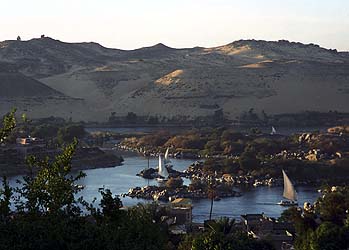The Nile River - For Kids
The Nile River played a big part in the creation and proliferation of the ancient Egyptian civilization. The majority of land in ancient Egypt was inhospitable desert, but the land around the Nile River was fertile and provided much of what the Egyptians needed.
Flowing across over 4,000 miles, the Nile River stands as the longest river in the world. Even though it is known as the life of ancient Egypt, it also flows through several other African countries. Scientists aren't entirely sure where the river comes from, but many believe it comes from Lake Victoria deep within the African continent.
The two main tributaries of the Nile are the White Nile and the Blue Nile. The river ends in a delta flowing into the Mediterranean Sea. The confusing names of Upper and Lower Egypt were related to the flow of the Nile. The reason for the confusion is that Upper Egypt was in the south and Lower Egypt was in the North.

© NASA - Satellite view of the Nile River
Crops of the Nile
The flooding of the Nile was what brought the ancient Egyptians the gift of fertile land. The soil along the river was rich and perfect for crops. The crops most important to the ancient Egyptians were papyrus, wheat and flax. Papyrus was a tall reed that they most famously made into the world's first paper, but also used it for sandals, baskets and much more.
However, wheat was what helped make the Egyptian civilization rich. They sold much of their wheat in the surrounding area and used it to make bread as a staple food. Flax was the crop used to make the linen clothing favored by the Egyptians.

© Jerzy Strzelecki - Boats on the Nile
Flooding and Cycles
The flooding of the Nile was so regular and predictable that the Egyptians based their seasons and calendar on it. The first season started in September with the flood and was called Akhet, meaning inundation. The second season was the growing season, or Peret. The third season was Shemu or the harvest season.
Each season was about four thirty-day cycles. The flooding was extremely important to the ancient Egyptians, as it was a sign that the year, and life, was beginning anew.

© GoShows - Harvest Season
Building and Transportation
Not only did the Nile River provide fertile land and crops for the ancient Egyptians, but it also provided building materials. The mud brick constructed from mud on the banks of the Nile served as the main building material for homes and the early mastaba tombs before pyramids took over. Hills near the Nile provided limestone and other rocks and minerals.
The Nile was so important that the majority of ancient Egyptian cities were built along its length. The river became a highway through the land, with ships traveling to and fro for trade and simple transportation. Pharaohs and other nobles would have fancy ships built for themselves and their entourage as they traveled up and down the river for pleasure.

Dhow on the Nile River near Aswan
Fun Facts
- The fertile black soil deposited by the flooding river every year was called the "Gift of the Nile."
- In the present day, the Aswan Dam prevents the Nile from flooding.
- The name for the Nile in ancient Egyptian was Aur, meaning black and related to the black soil deposited by the flood.
- The ancient Egyptians measured the flood every year as they considered it an indication for the quality of crops.
- Ancient Egyptians believed the Nile's flood was caused by the tears of their goddess Isis as she cried for the god Osiris, her husband.
